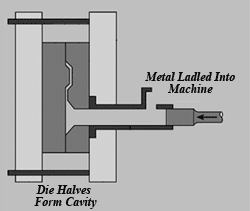Die Castings

The Die Casting process involves forcing molten metal into a mold or die. It is strictly a non-ferrous process with aluminum and zinc being the predominant materials. It is generally considered to be the highest volume of the casting processes. Die casting is considered by many to be two processes depending upon the material being cast. There are two types of die casting equipment used depending upon the material being cast. Cold chamber die casting is used for materials with a higher melting point such as aluminum. It is referred to as cold chamber because metal is ladled into the machine one shot at a time. Hot chamber die casting is for materials with a lower melting point such as zinc. Here the metal can be pumped directly from the furnace into the machine.
Cold Chamber (aluminum) Die Casting
The basic mold consists of two pieces one which is mounted stationary and another which moves back and forth. When pressed together under pressure they form a cavity which after metal is injected forms the part. The part is then ejected and the cycle repeats. Other features such as side holes are formed with the use of slides. Sprues and runners are cut into the die to provide a path for the metal to fill the cavity. These are removed after the part has cooled through the use of a trim die unique to the part being cast.
Hot chamber (zinc) die casting
Basic tooling is very much the same as with the cold chamber process. Zinc tooling is generally less expensive because it flows more readily therefore less force is used and in turn the tooling requires less mass than aluminum tooling. With some high speed zinc die casting metal is often injected directly into the part eliminating the need for separate trimming operations. Zinc can ordinarily fill smaller features than aluminum as well.
Design/Tooling Considerations
Tolerance +/- .015 as a general rule of thumb. Tighter tolerance is certainly available.
Draft – One degree, two degrees on cored features. Additional draft will endear you to your die caster and could extend tool life
Finish – 32 to 60 micro inch. Finer surface finish can be achieved, but often results in more frequent tool maintenance.
Wall thickness – .050” to .500. One should always strive to keep wall thicknesses as close as possible. Sharp corners should always be avoided.
Purchasing/Economic Considerations
Cavitation – Multiple cavity tooling results in a lower cost per part, yet a higher tooling cost. Volume and the expected life of the part are the prime considerations here.
Features -Part features to be formed by slides can save a secondary operation but increase the cost of the tool. Such features also increase the complexity of the die and naturally can affect its reliability.
Tool life – Aluminum tooling is usually good for 50,000-100,000 cycles (shots) before wear will start to become evident. Wear normally begins to show up in corners and fine detail in the part such as raised letters. Assume twice the tool life for hot chamber tooling. Less heat, less pressure, longer life.
Ownership – Die cast tooling is generally the property of the customer. Be aware if buying insert type tooling which fits into standard sized die sets. Not every die caster will have the die set that will enable your tooling to work. Dies are built to work in a certain tonnage (locking pressure) rated machine. Records should always be kept on the exact machine that your tooling is designed to run on. In terms of high speed zinc tooling, there are a myriad of machine models in the industry many of which are proprietary to a particular caster.
How we can help?
Where are the breakpoints in relation to number of cavities versus part cost? Will zinc really work in my application? My current die casting source has ceased operations, what do I do now? Over the past twenty five years we have seen it all when it comes to die castings. Die cast projects normally garner lots of attention within an organization due to the tooling expense. Let us help you get it right the first time.
